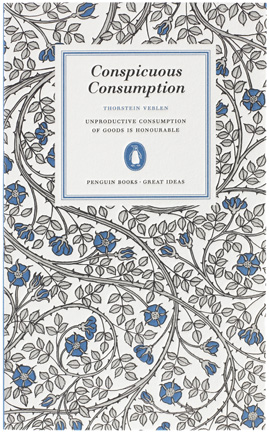60 in 60: #38 - Thorstein Veblen's Conspicuous Consumption (Penguin's Great Ideas Series)
 This blog post is part of my ongoing "60 Books in 60
This blog post is part of my ongoing "60 Books in 60 DaysYears" encounter with the Penguin Great Ideas series--the Guardian's book site of the week and mentioned on the Penguin blog a couple of times.The plan was to read one book in the series each night and post a blog entry about it the next morning, although this plan got derailed--first by deadlines and teaching, then by having fallen out of the rhythm, despite my best efforts--including a photo-essay on Thoreau (#37). My new plan is to read and blog about the remaining volumes as I have time and hopefully finish by year's end. For more on this beautifully designed series, visit Penguin's page about the books.CONSPICUOUS CONSUMPTIONby Thorstein Veblen (1857 to 1929)Memorable Line"It is worthy of notice that the possibility of producing pathological and other idiosyncrasies of person and manner by shrewd mimicry and a systematic drill have been turned to account in the deliberate production of a cultured class."The SkinnyVeblen's critique of capitalism and its more ridiculous follies has a dry quality to it that initially kindles ennui in the reader.Relevance? Argument?In a period when capitalism apes itself, celebrates its own excesses with an excess of satire that often entertains but rarely results in activism, Thorstein Veblen's thoughts on "Status and Servants," "Women, Luxury Goods, and Connoisseurship," the "Uselessness of Education," and other topics seem almost quaint. The gargantuan nature of the problem, the kind of super-viral form of capitalism that we feast upon and feasts upon us, almost seems to need something more colorful or more outrageous.Veblen's directness---rarely questioning, always stating, indulging in metaphor hardly at all---reinforces the abstract. I kept wanting something more concrete, even as I appreciated his various arguments. For this reason, chapters like "Canons of Taste: Greenery and Pets" perked up my interest more than the book's core. An examination of the common lawn, in particular, struck me as more concrete, perhaps because I have a complicated relationship with the lawn. In short, I like weeds.Indeed, I much prefer weeds and wildflowers, and the unkempt but more natural appearance they bring with them, to the sterile but more socially acceptable grass of your average lawn. For one thing, I like my environment to mimic my own state of mind (and my beard) while deep into the writing. For another, I am most at peace hiking and spending time in natural places. Having a reminder of the wilderness, even if it's just a patch of sedgeweeds, honeysuckle, blue petals, and assorted other "intruders," makes me happy. (I recognize that I diverge on this subject with the other members of the household, and thus the yard goes through periods of both civility and barbarism, each of us having a different opinion on which is which.)Veblen puts forth the lawn as an example of how "everyday life affords many curious illustrations of the way in which the code of pecuniary beauty in articles of use varies from class to class, as well as of the way in which the conventional sense of beauty departs in its deliverances from the sense untutored by the requirements of pecuniary repute."The lawn, Vebren argues, appeals especially to the "well-to-do classes" and "in those communities in which the dolicho-blond [Aryan] element predominates in an appreciable degree." The lawn has a "sensuous beauty" that "appeals pretty directly to the eye of nearly all races" (a rather interesting generalization) but particularly to "the eye of the dolicho-blond." Vebren claims this is because they had been "for a long time a pastoral people inhabiting a region with a humid climate." Therefore, they find a lawn beautiful because they're used to "contemplating a well-preserved pasture or grazing land."For some reason, perhaps because it's juxtaposed with fairly sophisticated verbiage, Veblen's next line made me laugh: "For the aesthetic purpose, the lawn is a cow pasture." He then more or less says that sometimes rich Aryans will get an expensive cow for their lawns to replicate, without the peasant squalor, a kind of genuine experience...and, of course, making an Epcot Center out of it regardless. Where a fancy cow cannot be found, a fancy deer will have to suffice, but in the heart of the Aryan this latter creature will create a lingering disappointment...that it is not a cow. Still, this disappointment at the insufficiency of the doppelganger---it's shape being different from a cow, as well as its mannerisms---is more than compensated for by the exotic quality of the deer-substitute. In other words, "superior expensiveness or futility."It was while contemplating the relative futility of cow versus deer that I began to think that perhaps Veblen had more of a sense of humor than I had been giving him credit for; I also began to wonder if he might be more of a crackpot than I gave him credit for...both states (humor, crackpot) being qualities I admire in a thinker or a writer (those two states often mutually exclusive).In any event, it's this chapter, with its thoughts on lawns and public parks that opened up the book for me, and made me finally have an inkling of belief in the "withering satire" description on the back of the book. "Canons of Taste: Greenery and Pets" also re-opened the closed case file stamped "60 in 60--FAIL!", as I had wrestled with the obsidian blankness of Veblen's opening words from "The Leisure Class" for several months. If I'd only thought to start with the common lawn I might've resurrected this series long ago.ConclusionNow that I have my compass bearings, I'll dive back into Veblen with a new appreciation. For this author, entry points may be the most important consideration for the interested reader.Question for ReadersHow do you like your lawn?Next up, Albert Camus' The Myth of Sisyphus...
